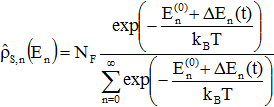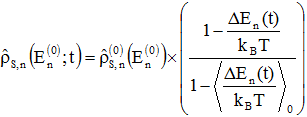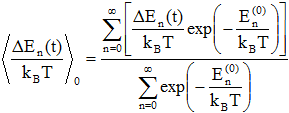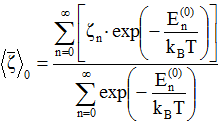QUANTUM ELETRICAL PHENOMENA AT LOW TEMPERATURES
Калытка В.А.1, Оспанов Б.С.2, Байдильдина Ж.Б.3, Рымханов Е.С.4
1Кандидат физико-математических наук, доцент, 2Магистрант, 3Преподаватель кафедры энергетические системы , 4Магистрант, Карагандинский государственный технический университет, Караганда, Казахстан
КВАНТОВЫЕ ЭЛЕКТРИЧЕСКИЕ ЯВЛЕНИЯ В ОБЛАСТИ НИЗКИХ ТЕМПЕРАТУР
Аннотация
Исследуется квантовый механизм миграционной поляризации в слоистых кристаллах в переменном электрическом поле в области низких температур. Вычисляется неравновесная матрица плотности для ансамбля невзаимодействующих протонов двигающихся в одномерном многоямном прямоугольном потенциальном рельефе возмущенном переменным поляризующим полем. Результаты квантово – механического исследования миграционной поляризации могут быть использованы при изучении туннельного механизма спонтанной поляризации сегнетоэлектриков (KDP,DKDP).
Ключевые слова: кристаллы с водородными связями (КВС), миграционная поляризация, протонная релаксация, неравновесная матрица плотности для протонов.
Kalytka V.A.1, Ospanov B.S.2, Baidil'dina Zh.B.3, Rymhanov Y.S.4
1PhD in Physics and Mathematics, Associate professor, 2Master student, 3Lecturer in energy systems, 4Postgraduate student, Karaganda State Technical University, Karaganda, Kazakhstan
QUANTUM ELETRICAL PHENOMENA AT LOW TEMPERATURES
Abstracts
Quantum mechanism of interlayer polarization in layered crystals in alternating electric field in the limits of low temperatures is studied. Unbalanced density matrix is calculated for the ensemble of noninteracting protons, moving in one-dimension multipit potential image of rectangular shape disturbed by variable polarizing field. Results of quantum-mechanical investigation of migratory polarization may be used in the study of tunnel mechanism of spontaneous polarization of ferrielectrics (KDP, DKDP).
Keywords: hydrogen – bonded crystals (HBC), interlayer polarization, proton relaxation, unbalanced proton density matrix. IntroductionThe investigating of nonlinear electrophysical, magnetic and optical properties of instrumental and constructional materials with compound structure of the crystal lattice (layered crystals, ceramics, MDS - structures) is an actual scientific - technical task, which decision should be built in a complex, on a combination of the experimental and theoretical results directed on detection of features of polarizing, magnetic and electrooptical effects in the field [1,2] of phase transition.
In the last 10 years considerable interest for physical materials science represents research of effects of a nanocrystalline state of dielectrics [3,4], semiconductors and a ferroelectric material in the range of low and ultralow temperatures that is important for space and medical technologies.
The kinetic phenomena excited by electric field, in various crystal structures, are reduced to the through movement of free electrons (conductivity current in conductors), diffusion –relaxation movement of interstitial ions [5, 6] (ionic conductivity and polarization in dielectrics), electronically – hole conductivity in semiconductors.
The studies of the kinetic phenomena at polarization and magnetization of a crystal, in case of distribution of carriers of a charge (or magnetic atoms) on levels of energy of a continuous range (classical statistics), has to be based on the solution of the kinetic equation of Boltzmann together with system of the equations of Maxwell under the set boundary conditions [1]. In a case distribution of particles on levels of energy of a diskette range research of statistical properties of system, in lack of degeneration, has to rely on quantum statistics of Boltzmann [2], and kinetics of polarizing and magnetic processes on the quantum kinetic equation of Liouville allowing to calculate the statistical operator of system depending on structure of its Hamiltonian revolted with an external field. From this point of view electrophysical and magnetic properties of various crystals in the wide range of tension of electric and magnetic fields and temperatures can be investigated on the basis of the uniform kinetic theory allowing to calculate experimentally measured macroscopic characteristics (polarization, magnetization) and, on this basis parameters of a crystal lattice and molecular parameters [2] the relaxing particles.
1. Unbalanced density matrix of many-particle system in external perturbationsWe will consider a system of interacting particles (relaxation oscillator) moving in a steady crystal potential field ![]() . Unperturbed Hamiltonian of separate particle [1] says
. Unperturbed Hamiltonian of separate particle [1] says
![]() (1)
(1)
The particles are distributed over the energy levels of the discrete spectrum ![]() , according to the [3] Liouville equation
, according to the [3] Liouville equation
![]() (2)
(2)
 (3)
(3)
where  statistic sum of system; NF - full quantity of particles in system. Unperturbed equilibrium (balanced) density matrix of the system takes the form
statistic sum of system; NF - full quantity of particles in system. Unperturbed equilibrium (balanced) density matrix of the system takes the form
 (4)
(4)
When imposing on a crystal of external perturbation ![]() , system of particles with Hamiltonian
, system of particles with Hamiltonian ![]() , described by the equation [3] of Liouville
, described by the equation [3] of Liouville
 (5)
(5)
The solution of the operator equation (5), in the first approximation of perturbation theory is constructed in the form ![]() [7], in the steady indignant state, going to asymptotic approach for the revolting amendment
[7], in the steady indignant state, going to asymptotic approach for the revolting amendment ![]() , write indignant stationary statistical system operator
, write indignant stationary statistical system operator
 (6)
(6)
In (6)  the statistical sum of indignant states. The indignant equilibrium (balanced) density matrix of systems has the form
the statistical sum of indignant states. The indignant equilibrium (balanced) density matrix of systems has the form
 (7)
(7)
In (7), power range of particles En it is calculated taking into account stationary indignation ![]() , in the linear approximation of the perturbation theory
, in the linear approximation of the perturbation theory ![]() , where
, where ![]() . For large periods of oscillation of the external field, accepting
. For large periods of oscillation of the external field, accepting ![]() [1, 2], we receive the quasi stationary indignant range of energy
[1, 2], we receive the quasi stationary indignant range of energy
![]() (8)
(8)
In (8) the expression ![]() is calculated as the slowly changed in time function.
is calculated as the slowly changed in time function.
According to (8), transform (7) into the type
 (9)
(9)
owing in the field of low indignations to ![]() and taking into account (4), we receive approximate expression
and taking into account (4), we receive approximate expression
 (10)
(10)
 (11)
According to
(11)
According to  [1], getting an approximate density matrix
[1], getting an approximate density matrix
 (12)
(12)
2. Quantum effects under polarization of dielectrics at low temperatures
The analysis of the experimental spectra of specific volumetric electric conductivity and tangent of dielectric losses of solid dielectrics with compound crystalline structure (layered minerals, ceramics) showed. That at high temperatures (T = 100 - 450 K) mechanism of dielectric relaxation is reduced to a thermo - activated threw relaxators (ions, dipoles) at the fastening (lattice sites) in the direction power lines (towards the electric lines) of the polarizing field (for cations; cation vacancies) or against the field (for anions, anion vacancies) [2].
The most effective relaxation polarization, is shown in hydrogen bonded crystals (HBC), classified by electrophysical properties in the voltage range of the polarizing field ![]() and temperatures
and temperatures ![]() K, as proton semiconductors and dielectrics [2] and characterized by proton conductivity - diffusive transfer of hydrogen ions [H+] (protons) along the hydrogen links towards the electric lines of polarizing field [2]. The totality of the polarization processes associated with relaxation - diffusive motion of the protons in the HBC is determined as a proton relaxation. The molecular mechanism of the polarization of the hydrogen sublattice in the HBC [2] allows classifying it as a migratory polarization.
K, as proton semiconductors and dielectrics [2] and characterized by proton conductivity - diffusive transfer of hydrogen ions [H+] (protons) along the hydrogen links towards the electric lines of polarizing field [2]. The totality of the polarization processes associated with relaxation - diffusive motion of the protons in the HBC is determined as a proton relaxation. The molecular mechanism of the polarization of the hydrogen sublattice in the HBC [2] allows classifying it as a migratory polarization.
The kinetics of a proton relaxation in the field of high temperatures is rather well investigated, both experimentally, and theoretically [1]. We measured the temperature spectra of thermally stimulated depolarization currents (TCDP) and frequency - temperature spectra of the tangent of dielectric losses ![]() in crystals of talc [1], mica and in plaster.
in crystals of talc [1], mica and in plaster.
A linear theory of dielectric losses, in good agreement with measurements of the spectra of density of TCDP J(T) in the HBC with a compound crystalline structure (mica, chalcanthite, phlogopite) [1]. For theoretical research of a low-temperature proton relaxation, in HBC, it is not enough linear approach on the polarizing field [2]. In the range of low temperatures (70 - 100 K), as showed experiment, the dominating contribution to migratory polarization in layered crystals is made by tunneling of protons inside and among [2] the ions of an anion sublattice.
So, studies of the quantum properties of an ensemble of relaxing protons conducted on the basis of the unperturbed (non - disturbed) Hamiltonian of whole the system (crystal) ![]() , without taking into account a proton – proton and a proton – phonon interaction
, without taking into account a proton – proton and a proton – phonon interaction ![]() , in adiabatic approximation
, in adiabatic approximation ![]() [1]. Then, we [2] accept to approach
[1]. Then, we [2] accept to approach
 (13)
(13)
where ![]() total number (full quantity) of protons relaxing at a predetermined activation energy U0 [1];
total number (full quantity) of protons relaxing at a predetermined activation energy U0 [1]; ![]() - unperturbed potential image for the proton [2]. By analogy with (12) with respecting (11), in the area of low fields, write the perturbed quasi stationary proton density matrix in the linear approximation of external indignation (perturbation)
- unperturbed potential image for the proton [2]. By analogy with (12) with respecting (11), in the area of low fields, write the perturbed quasi stationary proton density matrix in the linear approximation of external indignation (perturbation)
 (14)
(14)
In the (14) accepted the designations:  unperturbed balanced proton density matrix;
unperturbed balanced proton density matrix; ![]() - the statistical sum of system of the non - interacting protons distributed of levels
- the statistical sum of system of the non - interacting protons distributed of levels ![]() of unperturbed energy spectra. The parameter
of unperturbed energy spectra. The parameter  determined for the
determined for the  matrix element of dimensionless coordinate
matrix element of dimensionless coordinate ![]() ; d - crystal thickness. Upon based
; d - crystal thickness. Upon based ![]() [4], write the operator of the equilibrium concentration of excess
[4], write the operator of the equilibrium concentration of excess
![]() (15)
(15)
The wave functions ![]() of stationary states
of stationary states ![]() were calculated in [1]. The operator of polarization of a proton subsystem, in a variation field
were calculated in [1]. The operator of polarization of a proton subsystem, in a variation field ![]() [2] taking into account (15) takes the form
[2] taking into account (15) takes the form
![]() (16)
(16)
Full quantum mechanical averaging of the operator ![]() with the help of the wave functions of mixed states
with the help of the wave functions of mixed states ![]() [4], with respecting of (14), in approximation of unperturbed density matrix
[4], with respecting of (14), in approximation of unperturbed density matrix ![]() [1], finally gives
[1], finally gives
 (17)
(17)
The expression (17) can be used for the calculating of theoretical temperature spectra of stationary (at optic frequency) dielectric constant (SDC) and frequency spectra of complex dielectric permittivity (CDP) of HBC and ferroelectrics (KDP, DKDP). Use of the device of a matrix of density to research of tunneling of protons in a hydrogen sublattice of KDP, will allow, to open, at the molecular level, the quantum nature of electro-voltage effect and to predict nonlinear electrooptical properties [5,6].of a ferroelectric material near a point of phase transition.
Список литературы / References
- Калытка В.А. "Аналитическое исследование термостимулированных токов деполяризации в кристаллах с водородными связями при низких температурах" // Диссертация на соискание ученой степени кандидата физико – математических наук, по специальности 01.04.07 "физика конденсированного состояния", г. Томск,-2012. – Государственная публичная научно – техническая библиотека России. http://library.gpntb.ru.
- Анненков Ю.М., Калытка В.А., Коровкин М.В. Квантовые эффекты при миграционной поляризации в нанометровых слоях протонных полупроводников и диэлектриков при сверхнизких температурах // Известия Вузов. Физика. – 2015 г. – Т. 58, № 1. –С. 35 – 41.
- Ландау Л.Д., Лифшиц Е.М. Статистическая физика. –М.: Наука, 1989. – Т.9. – 186 с.
- Ландау Л.Д., Лифшиц Е.М. Квантовая механика. –М:Наука.1974. –Т. 3, –34 с .
- Лайнс M., Гласс А.Сегнетоэлектрики. M: Мир, –1981. –436 с.
- Левин А. А., Долин С.П., Зайцев A.P. Химическая физика. –1996. –Т. 15. – 84 с.
Список литературы на английском языке / References in English
- Kalytka V. A. ["An analytical research of thermostimulated currents of depolarization in crystals with hydrogen communications at low temperatures"]//the Thesis for a degree of the candidate of the physicist – mathematical sciences, in the specialty 01.04.07 of ["the physicist of the condensed state"], Tomsk,-2012. – [The state public it is scientific – technical library of Russia]. http://library.gpntb.ru.
- Annenkov Yu. M., Kalytka V. A., Korovkin M. V. [Quantum effects at migratory polarization in nanometer layers of proton semiconductors and dielectrics at ultralow temperatures]//News of Higher education institutions. Physics. – 2015 – V. 58, №. 1. – P. 35 – 41.
- Landau L. D., Lifshits E. M. [Statistical physics]. – M: Nauka, 1989. – V.9. – P. 186.
- Landau L. D., Lifshits E. M. [Quantum mechanics]. – M:Nauka, 1974. – V. 3, – P. 34.
- Layns M., Glass A. [Ferroelectrics]. M: Mir, –1981. – P. 436.
- Levin A. A., Dolin S. P., Zaytsev A.P. [Chemical physics]. –1996. – V. 15. – P. 84.
